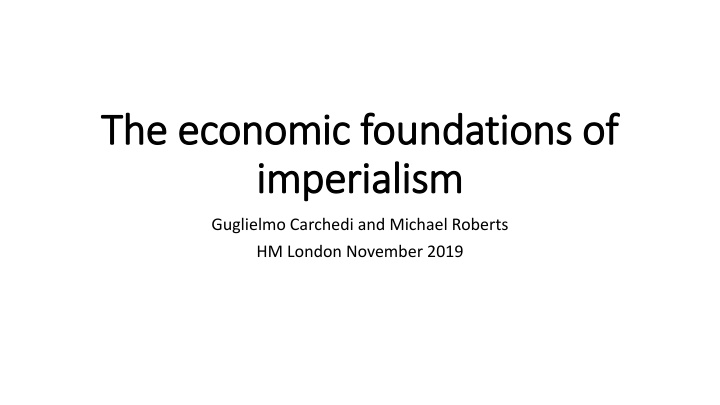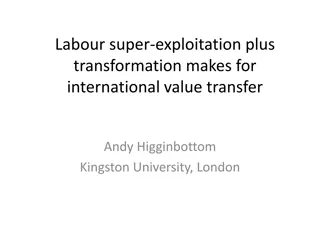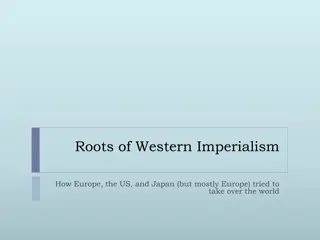Economic Foundations of Imperialism: Exploitation and Value Transfer
Imperialism primarily functions as an economic mechanism for exploiting value rather than seeking political dominance. The transfer of value occurs through mechanisms like unequal exchange, global value chain flows, and capital flows, leading to the long-term appropriation of value by imperialist nations. This process is stratified, with hierarchies of both imperialist and dominated countries based on technological development levels.
Download Presentation

Please find below an Image/Link to download the presentation.
The content on the website is provided AS IS for your information and personal use only. It may not be sold, licensed, or shared on other websites without obtaining consent from the author.If you encounter any issues during the download, it is possible that the publisher has removed the file from their server.
You are allowed to download the files provided on this website for personal or commercial use, subject to the condition that they are used lawfully. All files are the property of their respective owners.
The content on the website is provided AS IS for your information and personal use only. It may not be sold, licensed, or shared on other websites without obtaining consent from the author.
E N D
Presentation Transcript
The economic foundations of The economic foundations of imperialism imperialism Guglielmo Carchedi and Michael Roberts HM London November 2019
Many aspects of imperialism Imperialism is primarily an economic mechanism and not a political mechanism. Its basic aim is not political dominance but economic exploitation. The former is a means to achieve the latter and not a cause.
Focus on the transfer of value Its economic exploitation mechanism (international value transfers) works via normal capitalist competition and not only in monopolist competition (i.e. imperialist surplus-value extraction exists irrespectively of the existence of monopolist super-profits). Value flows from the dominated countries to the imperialist countries in a number of ways.
Ways to transfer value Unequal exchange through international trade Global value chain flows (transfer pricing) within multi-nationals Factor income flows (primary income from debt, equity and property) Seignorage (dollar is king) Capital flows (FDI inflows and portfolio flows)
The long-term appropriation of value By economic imperialism we mean the long-term international appropriation of value by the imperialist countries from subaltern countries. In the appropriation of surplus value, the level of technological development plays the central role. Imperialism refers first to the appropriation of surplus value by high technology companies from low technology companies in different countries. But imperialism refers also to flows of value between countries. So imperialist countries can be defined as those with a persistent high number of high technology companies as measured by their high national average OCC and thus whose average technological development is higher than the national average of other countries, which are thus economically dominated on this account.
Stratification of imperialism Imperialist countries tend to form blocs around themselves. Both the imperialist and the dominated countries are stratified. There is a hierarchy of imperialist countries (on the basis of the hierarchical structure of the OCCs) and a hierarchy of dominated countries. Most countries, including the US as the hegemonic imperialist nation, are both expropriators and expropriated of surplus value by virtue of the structure of their technological development. The difference is that the imperialist countries are net appropriators of surplus value for long periods, due to their persistently higher level of technological efficiency, especially in the high technology sectors.
Imperialism and sub-imperialism The well-established imperialist powers still sit at the top of the primary income pole. The vast majority of countries are forced to remain in a dominated role paying out much more than receiving in primary income. In our definition, there are no sub-imperialist countries, because the notion of sub-imperialism fails to focus on international differences in productivity differentials and misses the lack of persistent technological superiority.
Net primary income flows Net primary income ($m) Net primary income for BRICS 1994-2017 $m 600,000 50,000 500,000 0 Japan 400,000 -50,000 Can South Africa 300,000 Ita China -100,000 Fra India 200,000 Ger Russ -150,000 UK Bra 100,000 US TOTAL -200,000 Total 0 -100,000 -250,000 1977 1979 1983 1985 1989 1991 1993 1995 1997 1999 2001 2003 2005 2007 2009 2011 2013 2015 2017 1994 1996 1998 2000 2002 2004 2006 2008 2010 2012 2014 2016 1975 1981 1987
US: the hegemonic economic power Share of total gross primary income % 24.0 22.0 20.0 18.0 16.0 14.0 12.0 10.0 8.0 6.0 4.0 2.0 0.0 Canada Korea Turkey Italy Vietnam Ireland Chile Indonesia Colombia US Nigeria UK Russia Sweden Brazil Malaysia France Australia Germany Poland Luxembourg Spain Neth Japan China Philippines Switzerland India Hungary S Africa Mexico Argentina
Imperialism and the also rans Primary income credit/person $ 5000 4500 4000 3500 3000 2500 2000 1500 1000 500 0 Korea Turkey Australia Sweden Italy Chile Russia Indonesia Poland Colombia UK US Nigeria India France Vietnam Germany Brazil Canada Spain Malaysia China Philippines Hungary S Africa Japan Mexico Argentina
Imperialism owns the assets Foreign direct investment stock ($trn) 20 18 G8 includes Netherlands 16 14 12 10 8 6 4 2 0 1990 1991 1992 1993 1994 1995 1996 1997 1998 1999 2000 2001 2002 2003 2004 2005 2006 2007 2008 2009 2010 2011 2012 2013 2014 2015 2016 2017 G8 BRICS
Unequal exchange (UE) The main way to appropriate surplus value for imperialist countries from the periphery is through unequal exchange in international trade. UE is the gain/loss of value when the producers sell at internationally determined production prices. If the market price deviates from the production price, there is a further loss/gain of value.
Transfer of value North: 80c + 20v + 20s =120V. Rate of profit = 20/(80c+20v) = 20% Rate of exploitation = 20s/20v = 100% South: 40c + 60v + 60s= 160V. Rate of profit = 60/(40c+60v) = 60% Rate of exploitation = 60s/60v = 100% Total: 120c + 80v + 80s= 280V. Average rate of profit = 80s/(120c+80v) = 40%. The capitalists in the South get 160V in value out of their workers, while the capitalists in the North get 120V. The rate of profit in value terms in the North would only be 20% while it would be 60% in the South. But competition in the market equalizes the average rate of profit at 40%. So the market price of production for the North and South is now 140 and the North gets a transfer of value of 20 from the South. Thus the capitalists of the North get some of the value created by the workers in the South through price competition equalizing the rate of profit on the global market. North = 80c + 20v + 40s = 140P (compared to 120V), so transfer gain of 20. South = 40c + 60v + 40s = 140P (compared to 160V), so transfer loss of 20.
Method of computing UE To work out the country national output (in labour hours) P = C + V + S where C = No 11 (K) capital stock x depreciation ratio 13 as above = C consumed in annual production V = (N) no of employees (No 6) x w average real wage (No 21) as above. P = X Real GDP (no 10) S = P-(C+V) Then to adjust for the export sectors only; we adjust C +V +S by the share of exports to GDP for the bilateral trade. Source: World Bank for exports to GDP and IMF for direction of trade shares. Then we have C +V +S = EXPORT P for each country s export trade with the other. Assuming C,V,S are known for the export sectors. We compute the average rate of profit (ARP) = total surplus value divided by total capital invested in the export sectors. The market price (MP) is the value of the output before equalization in each country, i.e. MP = C+V+S. The production price (PP) = total capital invested (C+V) + (C+V)R. Finally, UE = PP (after equalization) MP (before equalization), i.e. loss or gain due to equalization. Source: Penn Extended World Tables 4. developed by Adalmir Marquetti from the Penn World tables
Transfer of value to G7 from dominated countries 140 Transfer of value from the dominated bloc to the G7 rises from $20bn a year in the 1960s; to $90bn in the 1970s, dropping off to $50bn in the 1980s. Then with China becoming the great trading force, there is a take-off from the late 1990s to reach over $120bn by the time of the Great Recession. 120 *Dominated = Brazil, India, China, South Africa, Mexico, Turkey 100 80 60 40 20 0 1963 1965 1967 1969 1971 1973 1975 1977 1979 1981 1983 1985 1987 1989 1991 1993 1995 1997 1999 2001 2003 2005
The hit to GDP The transfer of value is much higher as a share of GDP for the dominated countries (5-10% of GDP) than for the G7 (2-3%) although the negative transfer of value for the dominated has been declining. UE value transfer in trade between G7 and dominated economies as % of GDP 0.10 0.05 0.00 -0.05 -0.10 -0.15 Ricci*: Over the period, the global amount of value transfers, corresponding to the 1.8 percent of global value added for developing economies, the relative size of outflow transfers was very consistent, ranging from 10 to 20 percent of the domestic value added. -0.20 -0.25 -0.30 1963 1965 1967 1969 1971 1973 1975 1977 1979 1981 1983 1985 1987 1989 1991 1993 1995 1997 1999 2001 2003 2005 2007 *Unequal Exchange in the Age of Globalization, Review of Radical Political Economics 2019, Vol. 51(2) 225 245 G7 Dominated
Higher composition of capital.. From Marx s value theory, we would expect the imperialist countries to have significantly higher organic composition of capital and labour productivity than peripheral economies. Organic composition of capital relative to the US (=100) 90 82 80 71 70 60 50 40 30 17 16 20 10 0 G7 BRICS 1963 2008
.higher productivity of labour Labour productivity level relative to the US (=100) 90 81 80 70 64 60 50 40 30 21 20 15 10 0 G7 BRICS 1963 2008
Super-exploitation The question of super-exploitation in the less developed nations , as revealed by extremely low levels of poverty, has taken a prominent role in discussions over imperialism since the 1970s. In the lower technology countries (LTC), the OCCs are usually lower and the rate of profit (before global equalization) higher than in higher technology countries (HTC) because of lower productivity in LTCs. After the equalization of profit rates in trade, a part of the profits generated in LTCs (with lower OCCs) is lost to HTCs (with higher OCCs). So the rate of profit falls in the former. Capital in LTCs reacts by slashing wages, through the use of slaves and coolies .
Transfer of value with super exploitation North = 80c + 20v + 20s = 120V. Rate of profit 20s/(80c+20v) = 20% Rate of exploitation 20s/20v = 100% South = 40c + 30v + 90s = 160V. Rate of profit 90s/(40c+30v) = 130% Rate of exploitation 90s/30v = 300% Total = 120c + 50v + 110s = 280V. Average rate of profit 110s/(120c+50v) = 65% Through the transfer of values in the global market, the capitalists of the North now get an extra 45V out of the super-exploited workers of the South. Super-exploitation in the South increases profits for the North. Total surplus value in the North and South has risen from 80 in the first case to 110 in the super-exploitation case. North = 80c + 20v + 65s = 165P (compared to 120V), so transfer gain of 45. South = 40c + 30v + 45s = 115P (compared to 160V), so transfer loss of 45. MOST OF THE EXTRA SURPLUS VALUE FROM SUPER EXPLOITATION GOES TO THE NORTH. THE NORTH NOW GETS 65S COMPARED TO 40S BEFORE. BUT THE SOUTH ALSO GETS A HIGHER SURPLUS VALUE THAN BEFORE (45S COMPARED TO 40S BEFORE) THROUGH DRIVING WAGES BELOW THE VALUE OF LABOUR POWER.
Lower wages, higher rate of exploitation Wage levels in the G7 countries are about 70-80% of the US, while they are less than 20% in the BRICS. The lower wage level increases the rate of exploitation in those countries. Rate of surplus value relative to the US (%) 5.0 4.5 4.0 3.5 3.0 2.5 2.0 1.5 1.0 0.5 0.0 UK Ger Fra Ita Can Jap G7 Bra Ind Chin Russ SAFr BRICS 1963 2008
Exploitation depends on two factors not one The rate of surplus value is determined bothby labor s productivity and by the wages level. It is mistaken to focus exclusively either on the one or on the other. These two factors do not have the same importance; one is determinant and the other determined. Lower wages are a countervailing reaction to the lower labour productivity and OCC in LTCs. Through international trade, surplus value flows from the low wage countries to the high wage countries not because wages are lower in the former than in the latter, but because in the low wage countries the rate of surplus value is higher.
There is no international average Each country has its own value of labour power. Given the technologically determined necessary and surplus labour, the national values of labour power and the rate of surplus value fluctuate according to the power relation between the two fundamental classes in each country. Historically, specific features play also a role. What matters is the rate of surplus value between countries not relative to some international average rate of surplus value.
Value transfer with a trade surplus North = 80c + 20v + 20s = 120V. Rate of profit 20s/(80c+20v) = 20% Rate of exploitation 20s/20v = 100% South: 80c + 120v + 120s= 320V. Rate of profit = 120/(80c+120v) = 60% Rate of exploitation = 60s/60v = 100% Trade surplus for South rises from 40V to 200V Total: 160c + 140v + 140s = 440V Average rate of profit = 140s/(160c+140v) = 46%. Transfer of value: North 80c + 20v + 47s = 147 South 80c + 120v + 94s= 294 North gains 27s and South loses 27s in value even though trade surplus rises by 160V
China runs a huge surplus in trade with the US but has much lower productivity US deficit on trade with China $m Ratio of productivity of labour China-US (%) 0 25 -50000 20 -100000 -150000 15 -200000 -250000 10 -300000 5 -350000 -400000 1985 1987 1989 1991 1993 1995 1997 1999 2001 2003 2005 2007 2009 2011 2013 2015 2017 0 1950 1953 1956 1959 1962 1965 1968 1971 1974 1977 1980 1983 1986 1989 1992 1995 1998 2001 2004 2007 2010 2013 2016
China transfers value to the US in trade The US gains more value through UE with China in spite of China s greater economic growth and exports because China s economy and thus its exports are at a lower level of productivity. UE transfer of value US-China $bn 50 40 30 20 10 0 -10 1994 1995 1996 1997 1998 1999 2000 2001 2002 2003 2004 2005 2006 2007
Summary of UE results The productivity of labour is key to the transfer of value in trade between imperialist countries and the periphery The major cause of UE betweenimperialist countries is technological superiority. Differences in the rates of surplus value are significant but play a lesser role. Between the imperialist and the dominated countries, the main factor in UE is the different rate of surplus value. Exclusive emphasis on only one of these two factors is misleading. In the last analysis, the result depends on whether the ratio of the two rates of surplus value is greater or smaller than the ratio of the two organic compositions of capital
Imperialism rules The evidence shows that imperialism is an inherent feature of modern capitalism. Capitalism s international system mirrors its national system (a system of exploitation): exploitation of less developed economies by the more developed ones. The imperialist countries of the 20th century are unchanged it s the G7-10. There are no sub-imperialist economies. China is not imperialist on these measures. The transfer of value from the periphery to the imperialist core is rising.























